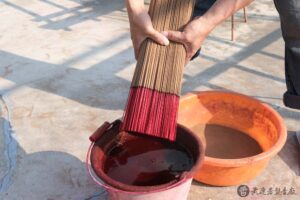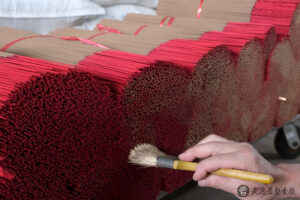Reporters/Ting-Yi Song, Shu-Yi Wang
Taiwan has a long history of religion, with incense stick being an indispensable tool for communicating with the gods. During Taiwan’s economic take-off period, the incense making industry thrived; however, due to difficulties in passing on the skills in making incense and rising environmental awareness, this industry has faced many challenges, manily smoke and pollution from combustion.

The origin of incense stick in Taiwan can be traced back to the Qing Dynasty when people brought their religious beliefs with incense as their amulets. According to the website of Taiwan’s Ministry of Culture and Tourism, the land of Taiwan began to be gradually settled and operated by people from the Zhang and Quan areas during the Qing Dynasty. Due to the unpredictable wind and waves in the Taiwan Strait and the turmoil in the initial stage of reclamation, people needed an invisible force to support them. At that time people also brought with them their religious beliefs from China. They believed that bringing Mazu across the sea to Taiwan will help them cross the sea safely and successfully reach the unknown land.
They also believed that the use of their incense sticks will bring together the three essences of smoke, fire and fragrance. In other words, if they wanted to send messages to the gods or ancestors, they needed to burn incense sticks to carry their wishes and prayers on their journey to the heavens.

Huang, Lian-Zong’s Road to Making Incense Sticks
Huang Lianfang is a well-known incense brand in Taiwan founded by Huang, Lian-Zong. Cheng, Tai-Mei, an employee of the company, mentioned that when Taiwan’s economy took off, it was a period when people were earning a lot of money. The speed of making money was so fast, such that it was relatively easy to start a business. Thus, people were willing to spend money on their religious beliefs. Huang, Lian-Zong made up his mind to invest in the incense industry and named it Huang Lianfang. He changed the word “Zong” to “Fang ”, which is the last characters of his name, as a manifestation of his expectations for his products. He hoped that his products will be fragrant and that all customers who buy the products will also like this fragrance.
Cheng, Tai-mei said at first the company was just a small incense shop in Taipei, an area where important economic development occured, and a place where it was relatively easy to find various resources. At that time, incense business has been in obscurity for more than 40 years. But as time went by, the business of the small shop gradually expanded. Thus, Huang, Lian-Zong, a native of Taichung, decided to return to his hometown to continue his incense business there.
Steps for Making Incense Sticks
The pre-processing of incense requires soaking bamboo sticks, tying the feet to remove the smell of bamboo, and marking the feet with incense. The next step is to sift, test and stir the powder. This step is the most important part of incense making, since the success or failure of the quality of the incense lies here. After pre-processing, incense making can actually start.
The first step is to build the foundation and prepare or eat the powder. This step is like building a house where the foundation must be laid. If the foundation is well built, the house will be stable. Making the incense is just the same as laying the foundation of a building which will ensure that the incense is of high quality. The second step is to spread the fragrance by soaking the water and eating the powder. The purpose of dipping the bamboo sticks in water again is to allow the powder to adhere evenly to the sticks. This step can also minimize inconsistencies in the thickness of the end of the incense.

The steps of making incense are very tedious and highly professional. Cheng, Tai-Mei pointed out that although the steps of each incense manufacturing factory are basically the same, each factory has its own unique details for incense making. Huang Lianfang Incense Factory pays much attention to pre- processing because it is a crucial step to determine the flavor of the incense.

Environmental Impact of Burning Incense Sticks
Burning incense produces large amounts of carbon dioxide, sulfur dioxide and other pollutants, which have a significant impact on air quality and people’s health. In recent years, with the rise of environmental awareness, many temples have started to actively promote incense reduction or incense elimination. In response to this issue, Cheng, Tai-Mei believed that this pose a major challenge for the incense industry. How to introduce environmentally friendly products without losing their characteristics is one of their major concerns.
Nowadays, more and more incense manufacturers have started to produce eco-friendly incense. When it comes to the difference between eco-friendly incense and traditional incense, Cheng,Tai-Mei said that for environmental protection, no bamboo sticks will be used and that there will be no incense feet after burning.

Moreover, the smoke produced when burning eco-friendly incense is very small since it is very thin. Burning incense will produce tar, which in turn will make the ceiling black. So people nowadays prefer to use eco-friendly incense since the smoke generated by burning is small, thus solving the problem of smoky ceilings. Although the process of making incense is the same for both traditional incense and eco-friendly incense, it is much more difficult to make eco-friendly incense since it is thin.



